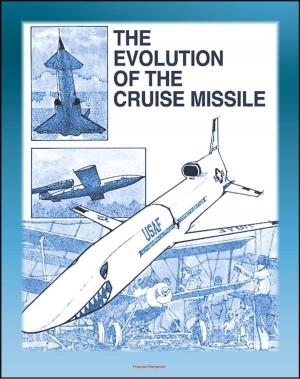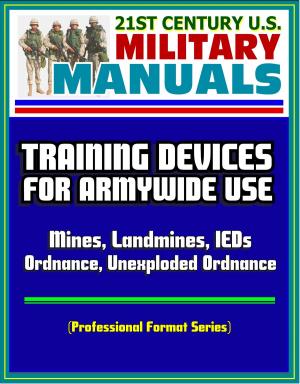Air Warfare: Historic Work by Iconic Early Leader of Army Air Corps and American Military Aviation: Principles, Combats and Defensive Formations, Pursuit, Bombardment, Attack, Antiaircraft Defense
Nonfiction, History, Military, Aviation, United States| Author: | Progressive Management | ISBN: | 9781370647606 |
| Publisher: | Progressive Management | Publication: | September 4, 2016 |
| Imprint: | Smashwords Edition | Language: | English |
| Author: | Progressive Management |
| ISBN: | 9781370647606 |
| Publisher: | Progressive Management |
| Publication: | September 4, 2016 |
| Imprint: | Smashwords Edition |
| Language: | English |
This excellent report has been professionally converted for accurate flowing-text e-book format reproduction. Written in 1926, this historic work by a pioneer of military aviation, William Sherman, provides a fascinating glimpse into the early days of American airpower. Contents:
Chapter I - Some Principles of Air Warfare * Human factor in war * Distinctive characteristics of air combat * Shock action * Mass psychology * Principles of economy of force, of the offensive, of security, and of simplicity. * Chapter II - The Characteristics of Aircraft * The Airplane: Design compromise * Speed * Useful load * Strength * Speed and human factor * Rate of climb and ceiling * Maneuverability * Performance factors * Power * Visibility * Maintenance * Weather and darkness effects * The Balloon.: Description and operation * The Airship: Non-rigid, semi-rigid and rigid types * Comparisons with airplanes * Chapter III - Individual Combats and Defensive Formations * Individual and mass air fighting * Aircraft machine guns and ammunition * Fundamentals of airplane gunnery * Dead spaces * Vulnerability * Single-seater combat * Loop * Tail-spin * Roll * Immelman turn * Single-seater versus two-seater * Defensive formations * Chains of formations * Chapter IV - The Service of Observation * Airplane Observation: General effect on war * Influence and lessons of World War * Qualifications and position of the observer * Tactical objectives * Effect of altitude and visibility * Reconnaissance * Liaison, contact, artillery, and exceptional missions. * Balloon Observation: Compared with airplane * Missions * Airship Observation: Balloon and airship * Airplane and airship * Chapter V - Pursuit Aviation * Basic Mission * Control of the air * Cooperation * Air barrages * Objectives * Formations * Attack of single airplane by a flight * Combat between two pursuit flights * Pursuit flight versus defensive formation * Squadron in attack * The group * command airplane * Interplane communication * The wing * The brigade * Chapter VI - Attack Aviation * Characteristics of attack airplane * Fundamental mission * Armament * Moral effect * Attack of column * Other targets * Employment as a reserve * Aids cavalry * Chapter VII - Bombardment Aviation * Post-war progress * Bomb development: demolition, Armor-piercing, chemical, incendiary, smoke and gas * Fuses * Sights * Tactical development * Objectives * Towns and cities * Supply systems * Industrial centers * Lines of communication * Overseas communications * Combat zone * Coast defense * Day and night bombardment * Chapter VIII - Antiaircraft Defense * Importance * Cannon * Accuracy * Difficulties of firing * Advantages and disadvantages * Harassing fire * Location of guns * Missions of machine guns * Defense of columns * Defense of a line and of areas * Listening apparatus * Searchlights * Balloon barrages * Air force * Information service * Defense of airdromes * Chapter IX - Notes on Air Logistics * Lessons of the World War * Airdromes * Personnel in movements of air units * Supply of units during movements * Regulation of movements * Normal supply methods * Chapter X - Naval Aviation * Terminology * Points in common with army air forces * naval aviation in World War * Naval aircraft characteristics * Sea airdromes and carriers * Observation * Bombardment * Tests in 1921 * Stationary and moving targets * Bombers and antiaircraft artillery * Protection by pursuit aviation * Plan of defense * Service of information * Ruses * Air battle * Attack on bombers * Inherent weakness of the defensive * Fleets having balanced air forces * Chemical bombs * Night bombing * Torpedo airplanes * Conclusions
This excellent report has been professionally converted for accurate flowing-text e-book format reproduction. Written in 1926, this historic work by a pioneer of military aviation, William Sherman, provides a fascinating glimpse into the early days of American airpower. Contents:
Chapter I - Some Principles of Air Warfare * Human factor in war * Distinctive characteristics of air combat * Shock action * Mass psychology * Principles of economy of force, of the offensive, of security, and of simplicity. * Chapter II - The Characteristics of Aircraft * The Airplane: Design compromise * Speed * Useful load * Strength * Speed and human factor * Rate of climb and ceiling * Maneuverability * Performance factors * Power * Visibility * Maintenance * Weather and darkness effects * The Balloon.: Description and operation * The Airship: Non-rigid, semi-rigid and rigid types * Comparisons with airplanes * Chapter III - Individual Combats and Defensive Formations * Individual and mass air fighting * Aircraft machine guns and ammunition * Fundamentals of airplane gunnery * Dead spaces * Vulnerability * Single-seater combat * Loop * Tail-spin * Roll * Immelman turn * Single-seater versus two-seater * Defensive formations * Chains of formations * Chapter IV - The Service of Observation * Airplane Observation: General effect on war * Influence and lessons of World War * Qualifications and position of the observer * Tactical objectives * Effect of altitude and visibility * Reconnaissance * Liaison, contact, artillery, and exceptional missions. * Balloon Observation: Compared with airplane * Missions * Airship Observation: Balloon and airship * Airplane and airship * Chapter V - Pursuit Aviation * Basic Mission * Control of the air * Cooperation * Air barrages * Objectives * Formations * Attack of single airplane by a flight * Combat between two pursuit flights * Pursuit flight versus defensive formation * Squadron in attack * The group * command airplane * Interplane communication * The wing * The brigade * Chapter VI - Attack Aviation * Characteristics of attack airplane * Fundamental mission * Armament * Moral effect * Attack of column * Other targets * Employment as a reserve * Aids cavalry * Chapter VII - Bombardment Aviation * Post-war progress * Bomb development: demolition, Armor-piercing, chemical, incendiary, smoke and gas * Fuses * Sights * Tactical development * Objectives * Towns and cities * Supply systems * Industrial centers * Lines of communication * Overseas communications * Combat zone * Coast defense * Day and night bombardment * Chapter VIII - Antiaircraft Defense * Importance * Cannon * Accuracy * Difficulties of firing * Advantages and disadvantages * Harassing fire * Location of guns * Missions of machine guns * Defense of columns * Defense of a line and of areas * Listening apparatus * Searchlights * Balloon barrages * Air force * Information service * Defense of airdromes * Chapter IX - Notes on Air Logistics * Lessons of the World War * Airdromes * Personnel in movements of air units * Supply of units during movements * Regulation of movements * Normal supply methods * Chapter X - Naval Aviation * Terminology * Points in common with army air forces * naval aviation in World War * Naval aircraft characteristics * Sea airdromes and carriers * Observation * Bombardment * Tests in 1921 * Stationary and moving targets * Bombers and antiaircraft artillery * Protection by pursuit aviation * Plan of defense * Service of information * Ruses * Air battle * Attack on bombers * Inherent weakness of the defensive * Fleets having balanced air forces * Chemical bombs * Night bombing * Torpedo airplanes * Conclusions















